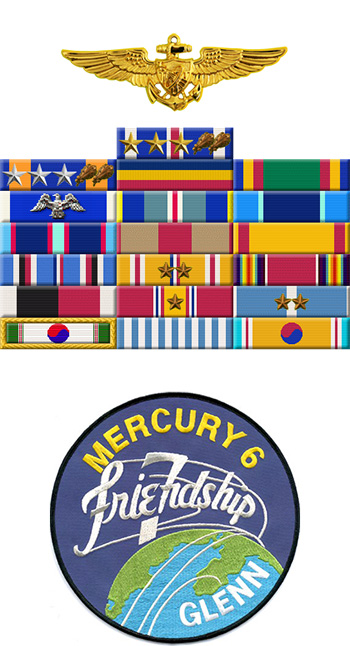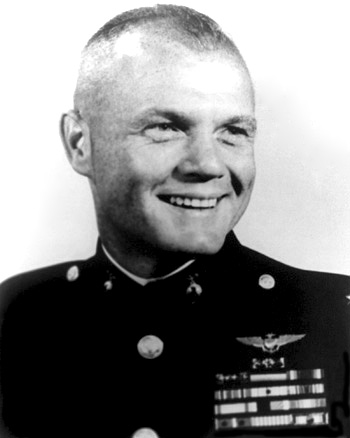
|
John H. Glenn, Jr. |
 |
|||
| Rank, Service | ||||
Colonel O-6, U.S. Marine Corps |
||||
| Veteran of: | ||||
|
||||
| Tribute: | ||||
John Glenn was born on July 18, 1921, in Cambridge, Ohio. He enlisted in the Aviation Cadet Program of the U.S. Navy on March 28, 1942, and was commissioned a 2Lt in the Marine Corps and designated a Naval Aviator on March 31, 1943. Glenn was assigned to VMF-155 as an F4U Corsair pilot in June 1943, and served in the Pacific Theater from February 1944 to February 1945, flying 59 combat missions. He next served with VMF-913 at Cherry Point, North Carolina, followed by an assignment at NAS Patuxent River, Maryland, where he served as a Test Pilot. Glenn served as Executive Officer of VMF-913 from September 1945 to January 1946, and as Operations Officer of VMF-323 at MCAS El Toro, California, from March to November 1946. From December 1946 to November 1948, Glenn served as Operations Officer of VMF-218, where he flew patrol missions in China and later moved to Guam. His next assignment was as an instructor pilot at NAS Corpus Christi, Texas, where he served until July 1951. Glenn attended amphibious warfare school from July to November 1951, and then served a staff assignment at Quantico, Virginia, from December 1951 to November 1952. After a brief tour at MCAS Cherry Point, Glenn was assigned to VMF-311 and flew F9F Panthers during the Korean War. He flew 63 combat missions with the Marines in Korea, followed by another 27 combat missions as an exchange pilot with the Air Force, where he was credited with the destruction of 3 enemy aircraft in aerial combat. After the war, Glenn returned to NAS Pax River, where he served as a Test Pilot from February 1954 to November 1956. He served with Headquarters USMC at the Pentagon from November 1956 to April 1959, when he was selected as one of the original Mercury 7 Astronauts. He became the 3rd American in space and the 1st to orbit the earth on February 20, 1962. Glenn resigned from NASA on January 30, 1964, and retired from the Marine Corps on December 31, 1964. John Glenn served as a United States Senator from Ohio from 1974 to 1999, and became the oldest person to go into space when he flew aboard the Space Shuttle Discovery during Mission STS-95 from October 29 to November 7, 1998. John Glenn married Anna Margaret Castor of Ohio on April 6, 1943, and they had two children, David and Carolyn. John Glenn died on December 8, 2016, and was buried at Arlington National Cemetery. |
||||
|
||||

